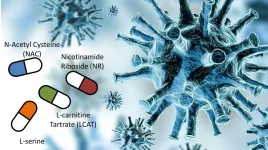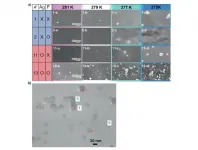(Press-News.org) The Structural Bioinformatics and Network Biology laboratory, led by ICREA Researcher Dr. Patrick Aloy, has completed the bioactivity information for a million molecules using deep machine-learning computational models. It has also disclosed a tool to predict the biological activity of any molecule, even when no experimental data are available.
This new methodology is based on the Chemical Checker, the largest database of bioactivity profiles for pseudo pharmaceuticals to date, developed by the same laboratory and published in 2020. The Chemical Checker collects information from 25 spaces of bioactivity for each molecule. These spaces are linked to the chemical structure of the molecule, the targets with which it interacts or the changes it induces at the clinical or cellular level. However, this highly detailed information about the mechanism of action is incomplete for most molecules, implying that for a particular one there may be information for one or two spaces of bioactivity but not for all 25.
With this new development, researchers integrate all the experimental information available with deep machine learning methods, so that all the activity profiles, from chemistry to clinical level, for all molecules can be completed.
"The new tool also allows us to forecast the bioactivity spaces of new molecules, and this is crucial in the drug discovery process as we can select the most suitable candidates and discard those that, for one reason or another, would not work," explains Dr. Aloy.
The software library is freely accessible to the scientific community at bioactivitysignatures.org and it will be regularly updated by the researchers as more biological activity data become available. With each update of experimental data in the Chemical Checker, artificial neural networks will also be revised to refine the estimates.
Predictions and reliability
The bioactivity data predicted by the model have a greater or lesser degree of reliability depending on various factors, including the volume of experimental data available and the characteristics of the molecule.
In addition to predicting aspects of activity at the biological level, the system developed by Dr. Aloy's team provides a measure of the degree of reliability of the prediction for each molecule. "All models are wrong, but some are useful! A measure of confidence allows us to better interpret the results and highlight which spaces of bioactivity of a molecule are accurate and in which ones an error rate can be contemplated," explains Dr. Martino Bertoni, first author of the work.
Testing the system with the IRB Barcelona compound library
To validate the tool, the researchers have searched the library of compounds at IRB Barcelona for those that could be good drug candidates to modulate the activity of a cancer-related transcription factor (SNAIL1), whose activity is almost impossible to modulate due to the direct binding of drugs (it is considered an 'undruggable' target). Of a first set of 17,000 compounds, deep machine learning models predicted characteristics (in their dynamics, interaction with target cells and proteins, etc.) for 131 that fit the target.
The ability of these compounds to degrade SNAIL1 has been confirmed experimentally and it has been observed that, for a high percentage, this degradation capacity is consistent with what the models had predicted, thus validating the system.
This work has been possible thanks to the funding from the Government of Catalonia, the Spanish Ministry of Science and Innovation, the European Research Council, the European Commission, the State Research Agency and the ERDF.
INFORMATION:
For the first time, scientists from the German Cancer Consortium (DKTK) partner site in Essen/Düsseldorf have discovered stem cells of the hematopoietic system in glioblastomas, the most aggressive form of brain tumor. These hematopoietic stem cells promote division of the cancer cells and at the same time suppress the immune response against the tumor. This surprising discovery might open up new possibilities for developing more effective immunotherapies against these malignant brain tumors.
The DKTK is a consortium centered around the German Cancer Research Center (DKFZ) in Heidelberg, which has long-term collaborative partnerships with specialist oncological centers at universities across Germany.
Glioblastomas ...
Metabolic activators were found to reduce recovery time by as many as 3.5 days in patients with mild-to-moderate Covid-19, according to a Swedish-British study published today in Advanced Science.
The researchers also found that treatment with the metabolic activators improved liver health and decreased the levels of inflammation, as shown by inflammatory markers.
Conducted by researchers at Science for Life Laboratory at KTH Royal Institute of Technology in Stockholm, in collaboration with the Sahlgrenska Academy in Gothenburg and King's College, London, the ...
Want to have a happy relationship? Make sure both partners feel they can decide on issues that are important to them. Objective power measured by income, for example, doesn't seem to play a big role, according to a new study in the "Journal of Social and Personal relationships" by the Martin Luther University Halle-Wittenberg (MLU) and the University of Bamberg. Instead, how lovers perceive power dynamics in their relationship is most important for relationship satisfaction.
Power is about being able to influence people and successfully resist the attempts of others to influence you. "It sounds like a dog-eat-dog world or the world of business. ...
The examined tissue does not need to be marked for this. The analysis only takes around half an hour. "This is a major step that shows that infrared imaging can be a promising methodology in future diagnostic testing and treatment prediction," says Professor Klaus Gerwert, director of PRODI. The study is published in the American Journal of Pathology on 1 July 2021.
Treatment decision by means of a genetic mutation analysis
Lung tumours are divided into various types, such as small cell lung cancer, adenocarcinoma and squamous cell carcinoma. Many rare tumour types and sub-types also exist. This diversity hampers reliable rapid diagnostic methods in everyday clinical ...
There are spiders that eat snakes. Observations of snake-eating spiders have been reported around the world. Two researchers from Basel and the US consolidated and analyzed over 300 reports of this unusual predation strategy.
Spiders are primarily insectivores, but they occasionally expand their menu by catching and eating small snakes. Dr. Martin Nyffeler, arachnologist at the University of Basel, and American herpetologist Professor Whitfield Gibbons of the University of Georgia, USA, got to the bottom of this phenomenon in a meta-analysis. Their findings from ...
Announcing a new article publication for BIO Integration journal. In this article the authors Chunxiong Zheng, Mingqiang Li and Jianxun Ding from Sun Yat-sen University, Guangzhou, China and Changchun Institute of Applied Chemistry, Changchun, China discuss the challenges and opportunities of nanomedicines in clinical translation.
Researchers are rapidly gaining a much deeper understanding of the challenges and opportunities of nanomedicines allowing for improvements in disease treatment and improved patient survival.
Deep exploration of the connections between preclinical and clinical ...
In March 2020, daily life in the United States changed in an instant as the country locked down to deal with the initial wave of the COVID-19 pandemic. New research reveals how residents in one community returned to their routines as the restrictions lifted, according to a team of Penn State scientists.
"We used sound signals captured by underground fiber-optic sensors to understand how COVID measures impacted human activities," said Junzhu Shen, a graduate student in geosciences at Penn State. "These sensors provide very accurate, high-resolution data that can help us understand what's happening in our communities."
The scientists analyzed sound data recorded from March through June 2020 in and around the Penn State University Park campus and State College, ...
Researchers have developed smart wound dressings with built-in nanosensors that glow to alert patients when a wound is not healing properly.
The multifunctional, antimicrobial dressings feature fluorescent sensors that glow brightly under UV light if infection starts to set in and can be used to monitor healing progress.
The smart dressings, developed by a team of scientists and engineers at RMIT University in Melbourne, Australia, harness the powerful antibacterial and antifungal properties of magnesium hydroxide.
They are cheaper to produce than silver-based dressings but equally as effective in fighting bacteria and fungi, with their antimicrobial power lasting up to a week.
Project leader Dr Vi Khanh Truong said the development of cost-effective antimicrobial ...
Results of this technique, known as transfer learning, achieved a 99.24 per cent success rate when detecting COVID-19 in chest x-rays.
The study tackles one of the biggest challenges in image recognition machine learning: algorithms needing huge quantities of data, in this case images, to be able to recognise certain attributes accurately.
ECU School of Science researcher END ...
Osaka, Japan - Scientists at Osaka University, Panasonic Corporation, and Waseda University used scanning electron microscopy (SEM) and X-ray absorption spectroscopy to determine which additives induce crystallization in supercooled aqueous solutions. This work may lead to the development of new energy storage materials based on latent heat.
If you put a bottle of water into the freezer, you will expect to pull out a solid cylinder of ice after a few hours. However, if the water has very few impurities and left undisturbed, it may not be frozen, and instead remain as a supercooled liquid. Be careful, because this state is very unstable, and the water will crystallize quickly if shaken or impurities are added - as many YouTube videos will attest. ...




